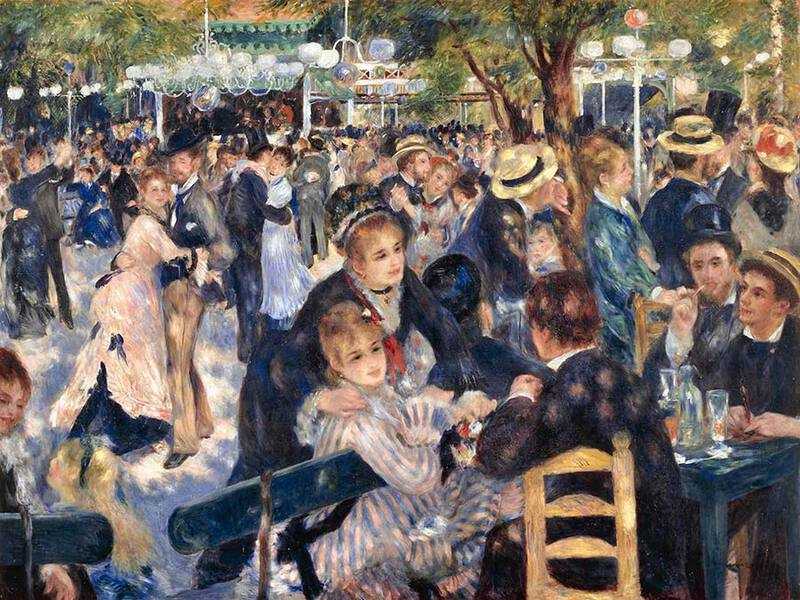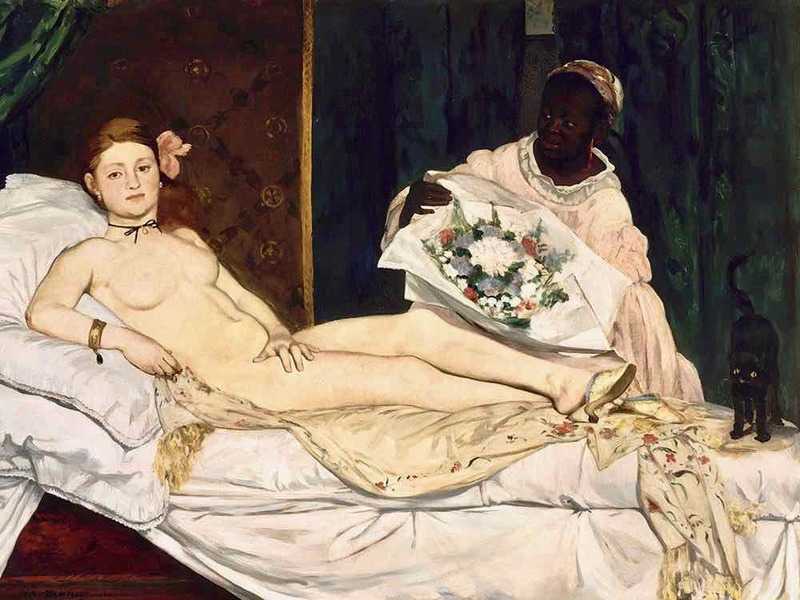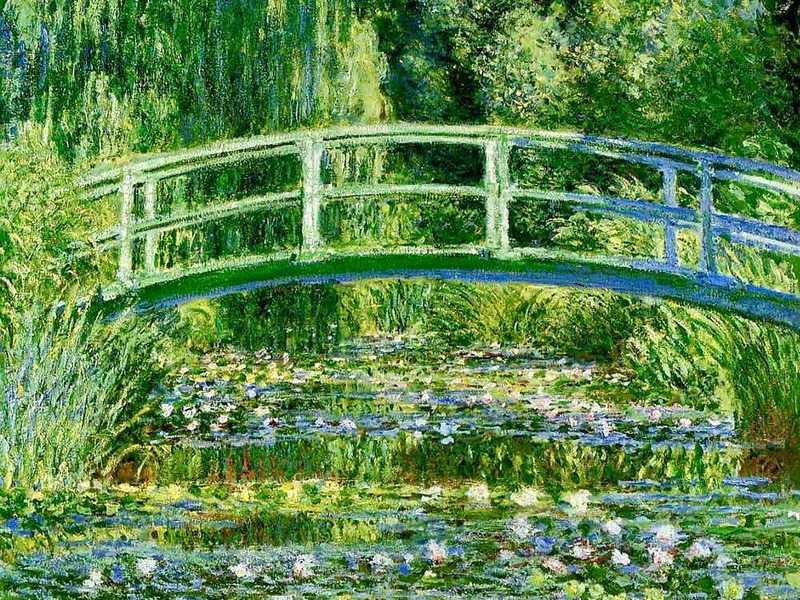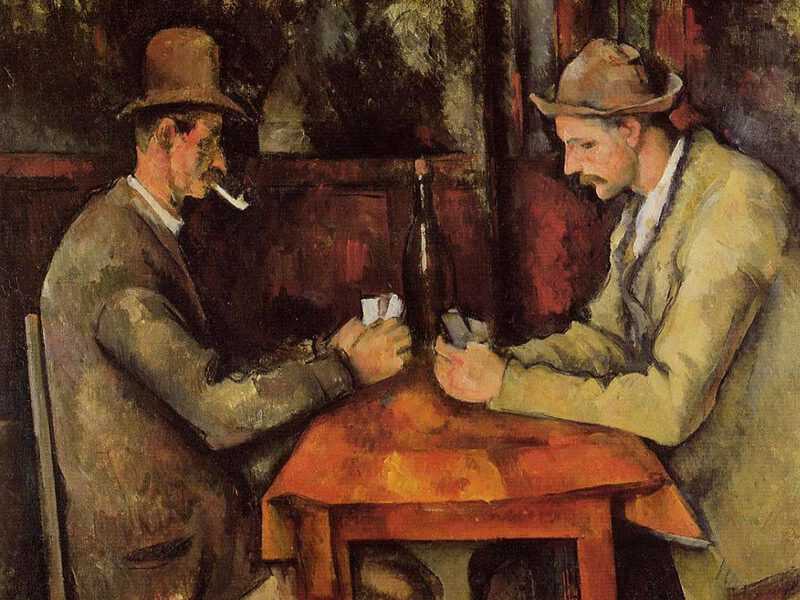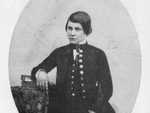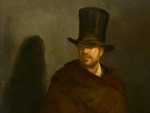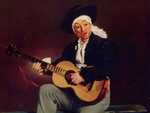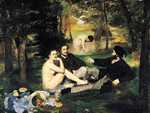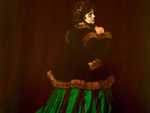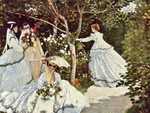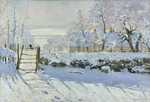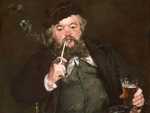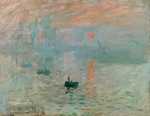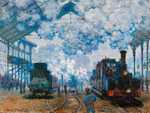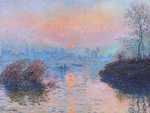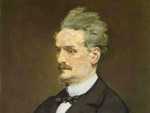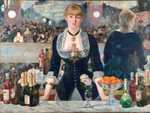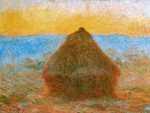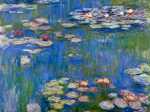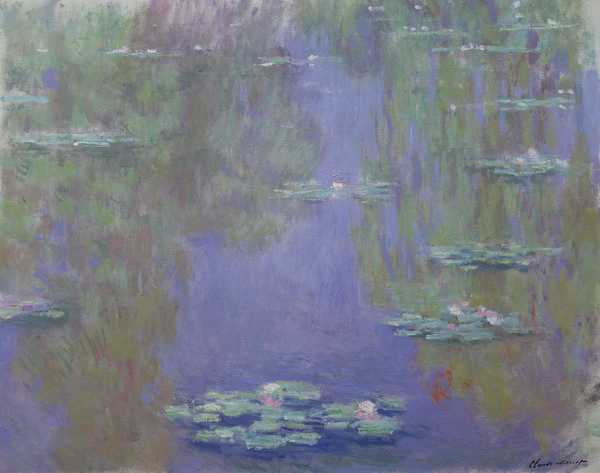1. 1830-60: The impressionists are born and come to Paris
1830: Camille Pissarro is born on the Island of St Thomas in the Danish West Indies on 10 July. His father was a merchant who had moved to the Caribbean to take over the family hardware store.
1832: Edouard Manet is born in Paris on 23 January. His parents are wealthy: his father a senior civil servant and later a judge; his mother the goddaughter of the crown prince of Sweden.
1834: Edgar Degas is born in Paris on 19 July; his father is also wealthy, owning the De Gas bank.
1839: Paul Cezanne is born in Aix-en-Provence on 19 January; his father also owns a bank.
1840: Claude Monet is born in Paris on 14 November, the son of a Parisian shopkeeper.
1841: Pierre-Auguste Renoir is born in Limoges, France, on 25 February. The son of a tailor, Renoir (like Monet) did not have the advantage of family money to help his career.
1841: Frederic Bazille is born in Montpellier, France, on 6 December.
1841: American John Goffe Rand patents his invention for a collapsible metal paint tube. Up until now, paint was difficult to make (usually by turning a powdered pigment into paste) and transport (often in jars or bladders made from animal skin). Rand's invention made painting outside a practical proposition. As Renoir later said:
"Without colours in tubes, there would be no Cezanne, no Monet, no Pissarro, and no Impressionism."
December 1848: The 16 year-old Manet, whose father wanted him to join the navy, sets sail on a merchant ship for Rio de Jainero. During the three-month crossing he resolves not to become a sailor.
Interesting fact...
Manet's voyage to Rio was certainly eventful: he was terribly seasick, attended the Rio Carnival, got bitten by a snake, and taught the crew how to draw!
1850-6: Manet studies at the studio of Thomas Couture, a landscapist; Couture encouraged Manet to develop his own style, though the two men sometimes quarrelled.
1859: Manet submits The Absinthe Drinker to the Salon of the Academy des Beaux Arts; it is rejected, with only one of the 12 jurors (Delacroix) voting in favour. Manet said:
“So they’d prefer me to do a nude, would they? Fine, I’ll do them a nude.”
The nudes he was contemplating arrived in 1863 (Lunch on the Grass) and 1865 (Olympia) and shocked the art world.
2. 1860-65: Manet throws down the gauntlet
1859-60: Monet comes to Paris and studies at Suisse's studio (where he meets Pissarro); he is then conscripted into the army, serves in Algeria, catches typhoid fever and returns to Le Havre. He finally returns to Paris to study at Gleyre's Studios (where he meets Renoir, Bazille and Sisley), and is provided with an allowance on the condition that he tries to obtain entry to the Ecole des Beaux Arts (the Fine Arts School).
1861: Manet submits two works to the Salon. The first, a portrait of his parents, was accepted but attracted critical reviews. But the second, a painting entitledThe Spanish Singer, won an honourable mention. Manet was not to receive any further recognition from the Salon for 20 years.
1863: Manet submits Dejuner sur l'Herbe (Lunch on the Grass) to the Salon. It is rejected, but an alternative exhibition for rejected works is organised on the orders of Napoleon III (the Salon des Refuses, literally 'the Exhibition of the Rejected'). The work receives a hostile reaction from the public and critics alike. One critic says that it had been
"painted with a floor mop".
Another critic said that the painting was Manet's idea of a practical joke.
1865: Manet submits Olympia to the Salon. It is, surprisingly, accepted by the jury. We say 'surprisingly' because Olympia is a painting of a naked, reclining prostitute looking brazenly at the viewer.
The reaction from the public and critics alike is so hostile that Manet flees to Spain to escape. For example, one reviewer referred to Manet's model, Victorine Meurant, as a
"female gorilla".
Monet has better luck: his two seascapes receive positive reviews and Manet was irked because he thought that Monet was trading off his name.
3. 1865-71: Mixed results at the Salon and War
1866: Monet's work, Woman in the Green Dress, is accepted by the jury and receives positive reviews. Manet, still reeling from the previous year's criticisms, does not submit.
1867: Monet's work, Women in the Garden (pictured), is rejected by the Salon's jury. Monet first floats the idea of the impressionists exhibiting together, but the plan is taken no further due to a lack of funds.
Interesting fact...
Manet's submissions are also rejected. He erects a pavilion and holds his own solo exhibition to coincide with the World Exhibition being held in Paris that year, at a cost of 17,000 francs (advanced by Manet's mother out of his inheritance); but few people come and the project does little to burnish Manet's reputation.
1869: Monet's two submissions, The Magpie (one of Monet's best snowscapes now found in the Musee d'Orsay) and a seascape called Fishing Boats at Sea, are rejected by the Salon's jury.
March 1870: Monet's submission of a portrait of his son, entitled Jean Monet, is rejected by the Salon's jury.
19 July 1870: Napoleon III declares war on Prussia.
19 September 1870: The Siege of Paris begins. Manet and Berthe Morisot stay in Paris to protect the city; Monet travels to London with Camille and his son Jean; Pissarro also moves to London with his family; Renoir is conscripted into the army; and Cezanne avoids conscription by hiding in a small village near his home town of Aix-en-Provence.
28 November 1870: Bazille is killed in fighting in the Battle of Beaune-la-Rolande, a failed attempt to break or at least relieve the Siege of Paris.
28 January 1871: The Siege of Paris comes to an end, after over four months. Paris has been devastated by shelling and many have died of hunger or disease. Emperor Napoleon III abdicates with the loss of the war, goes into exile in England, and the Third Republic begins.
Manet travels to the seaside town of Archachon to be reunited with his wife and son and to recuperate. He does not return to Paris, which is temporarily taken over by communists who briefly form a city-state known as the Commune, for several months.
4. 1874-79: The first four impressionist exhibitions
1873: Manet has a rare Salon success with his painting of a Parisian man smoking his pipe and drinking beer. The picture, called Le Bon Bock (the Good Beer), caught the public mood in the aftermath of the Prussian war and the fall of the Second Empire which followed it. This success may have convinced Manet not to participate in the first impressionist exhibition held the next year.
1874: The first impressionist exhibition is held. The main organisers were Monet, Pissarro and Degas, with additional exhibitors including Renoir, Cezanne and Berthe Morisot. Manet refused to take part, preferring to focus on conquering the Salon.
Interesting fact...
The exhibition was a major failure. For one thing, the reviews were hostile. For example, Monet's Impression Sunrise was compared with wallpaper in a formative state. For another, the company created to put on the exhibition was disbanded at the end of the year, having incurred a substantial loss (each exhibitor owed 278 francs!).
1876: The second impressionist exhibition is held. Gustave Caillebotte (1848-1894, who was independently wealthy and had joined the group) provided the finance and attended to most of the organisation. The main impressionists all exhibited with the exception of Manet. And, again, the exhibition was a failure: there were few sales and the reviews were terrible.
Interesting fact...
The second impressionist exhibition is well-known for a review by Albert Woolf, calling the impressionist "lunatics" and "daubers" and comparing them to inmates in a Parisian asylum. There were, however, one or two small signs of encouragement: Henry James wrote a positive article for the New York Tribune and Monet sold his Japanese Girls for 2,000 francs.
1877: The third impressionist exhibition is held, at impressive premises on rue Le Peletier. It was organised and financed by Caillebotte. Exhibitors included Monet (with 30 works, including 17 of Gare Saint Lazare), Renoir (with 17 works), Cezanne (16 works), Degas, Sisley, Berthe Morisot and Caillebotte himself.
But the reviews were again mainly hostile. For example, the Arts Chronicle said that
"children entertaining themselves with paper and paints do better"
Another said that the impressionist effect was similar to "worm-eaten Roquefort cheese".
1879: The fourth impressionist exhibition is held. Cezanne, Renoir and Morisot decline to participate. On the other hand, 15,000 people attend (almost four times the number that saw the first exhibition); Monet's Rue Montorgueil is the star of the show. American impressionist Mary Cassatt paticipates for the first time.
5 September 1879: Camille Monet, Monet's first wife, dies aged just 32, leaving Monet with two children to care for. Camille's death came during a terrible period for Monet: one of his main patrons, Ernest Horschede, was declared bankrupt a few years earlier and the Monet and Horschede families had moved in together to economise. Monet was left sending scores of letters to friends and collectors begging for money.
5. 1880-86: More exhibitions; glimmers of hope
1880: The fifth impressionist exhibition is held. Monet refuses to participate, preferring to give the Salon another go. His work, Sunset on the Seine at Lavacourt (pictured), is accepted, but it is "skied" (i.e. placed near the ceiling so that it was difficult for visitors to see). Renoir, Sisley and Cezanne also decide not to participate.
1881: The sixth impressionist exhibition is held. It marked a low point for the cohesion of the impressionist movement. Degas assumed command and insisted on (1) excluding artists who also wanted to show their works at the Salon and (2) including many of his artist friends even though they weren't impressionists. As a result, the only core impressionists who exhibited were Pissarro, Morisot and Degas himself. On the other hand, Pissarro received positive reviews, Degas unveiled his first sculpture of a ballerina, and Mary Cassatt burnished her reputation.
1881: Manet finally wins a medal at the Salon, awarded for a portrait of a political figure called Henri Rochefort. Whilst the medal is only second class, it provides some vindication for Manet's strategy of refusing to participate in the independent exhibitions. It also meant that Manet could participate in future Salons without having to have his works approved by the Jury. Later that year, Manet is awarded the legion d'honneur by the French state (thanks to his childhood friend Antonin Proust, who had become Minister for Fine Arts).
1882: The seventh impressionist exhibition is held. Monet, Renoir and Sisley all participate, largely at the insistence of Paul Durand-Ruel (who had fallen on hard times). Degas refuses to participate because the other artist's insist that the seventh exhibition should be for impressionists only. Pissarro and Morisot participate as usual. The exhibition is a success, resulting in positive reviews and sales. The most famous work displayed was Renoir's Luncheon at the Boating Lake.
1882: Manet's last major work, The Bar at the Folies Bergere, is exhibited at the Salon. The reviews are mainly negative.
1883: Manet dies of syphilis; Monet moves to Giverny; and Monet's solo show at Durand-Ruel's Paris gallery produces favourable reviews. As a result, Durand-Ruel holds a number of other solo shows: Renoir (April); Pissarro (May); and Sisley (June).
1883: The first major exhibition of impressionist work is held in America. Over the next decades, America was the key market for the sale of impressionist works.
1884: A posthumous exhibition of Manet's works is held at the Louvre.
1886: The eighth and final impressionist exhibition is held. But Monet, Renoir and Sisley refuse to participate. As such, the final exhibition is not a glorious fanfare to a decade of independent exhibitions - though Morisot and Pissarro exhibit as usual. The most famous work to be shown was Georges Seurat's La Grande Jatte.
1886-8: Vincent van Gogh, the leading post-impressionist and perhaps the most famous painter of all time, spends time with Pissarro, Gauguin and Seurat in Paris. This results in him lightning his palette from the earthy tones that are used in early van Goghs such as the Potato Eaters.
6. 1887-1926: Gradual recognition
1888-90: Van Gogh moves to Arles in the south of France and Gaugin later moves in with him. The next two years were tumultuous: van Gogh produced many of his most famous works; but he sliced off his left ear in December 1888 and gave the bloody flesh to a brothel worker; van Gogh continued to struggle with his mental health until he committed suicide in July 1890.
1890: Monet organises a collection to buy Manet's Olympia from Manet's widow for the French state. He raises almost 20,000 francs. But the authorities initially refuse to hang it in the Louvre, exhibiting it instead in the museum devoted to living artists: the Musee du Luxembourg.
1889-92: Monet paints his Haystacks series.
May 1891: Paul Durand-Ruel exhibits 15 versions of Monet's Haystacks. They sell within three days for prices of as much as 1000 francs. Monet uses the money to buy and extend the Giverny property that he is renting.
1890-95: Cezanne produces the five versions of his Card Players. One of the set holds the world record price for an impressionist work: it was sold in 2011 for $259 million.
1892-3: Monet paints his Rouen Cathedral series. Despite calls for it to be purchased by the French state, the works are snapped up by foreign buyers at an 1895 exhibition and dispersed around the world (particularly to America).
1890s: Monet starts work on his Water Lilies series, which would be the artistic focus of the rest of his life. In total, Monet painted over 250 versions of the Water Lilies. By this stage, demand for Monet's work and prices have skyrocketed. This trend has continued: two versions of the Water Lilies have been sold in the past decade for over $80 million.
1895: The art dealer Ambroise Vollard holds an exhibition of 152 of Cezanne's works. He sells a number of them, the first popular success enjoyed by Cezanne.
1895: Berthe Morisot, the leading female impressionist, dies aged 54.
1897: The Nationalgalerie in Berlin buys one of Cezanne's works.
1897: Monet returns to London, where he spent the Prussian war, and works on his Thames series (paintings of the Houses of Parliament and bridges over the Thames).
1899: Vollard holds another one-man show of Cezanne's work; a number of paintings fetch significant prices.
1900: The World Exhibition is held in Paris. The Arts Pavilion is filled with works from other 19th century French artists, including Ingres, Delacroix and Corot. But only two impressionist works feature: Manet's Dejeuner sur l'Herbe and a Monet Water Lily.
1906: Cezanne is caught in a storm whilst out painting, catches pneumonia and dies on 22 October.
1907: Manet's Olympia is finally hung in the Louvre.
1909: An exhibition is held in Paris of 48 of Monet's Water Lilies. Sales are fantastic, with the Gazette des Beaux-Arts declaring that:
"For as long as mankind has been around, and for as long as artists have painted, no one has ever painted better than this."
1912: The American collector Louisine Havermeyer buys Degas' Dancers at the Barre for 478,500 francs, almost doubling the record price for a work by a living artist.
June 1914: Fourteen of Monet's works are hung in the Louvre. This was the rarest of honours for a living artist. The works were left to the Louvre by Count Isaac de Camondo and were hung in an impressionist room which already included works by Manet and Cezanne. They included Monet's paintings of Hornfleur, Rouen Cathedral and his Giverny Water Lilies.
1914-1918: The First World War takes place. Monet refuses to leave Giverny, even though much of the fighting is taking place less than 200 kilometres away.
1917: Degas dies.
1919: Renoir dies.
1922: Monet comes to an agreement with Georges Clemenceau, the French Prime Minister, for the donation of a number of his water lilies to the state on his death. They are now held in a purpose-built museum in Paris called the Musée de l'Orangerie.
1922: Monet sells one of his Water Lily series to the Japanese collector Kojiro Matsukata for a reported price of 800,000 francs, smashing the record price for a work by a living artist set by Degas a decade previously.
1926: Monet dies. A collection of vast water lily canvasses are donated to the French state and are now found in the Musee de l'Orangerie in Paris.
1990: Renoir's Bal du Moulin de la Galette is sold at auction for $78 million, at that stage the second highest price ever paid for a work of art.
2002: One of Cezanne's The Card Players is sold for $259 million, at that stage the highest price ever paid for a painting (it is now third on a list headed by da Vinci's Salvator Mundi).
June 2008: One of Monet's Waterlilies is sold by Christie's London for £40.9 million, giving it an adjusted price of $113 million.
May 2009: One of Monet's Haystacks is sold by Christie's New York for $110.7 million. It turned out to be quite the investment: it was bought in 1986 for just $2.5 million!

